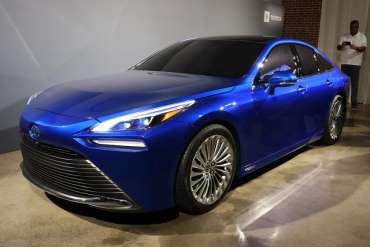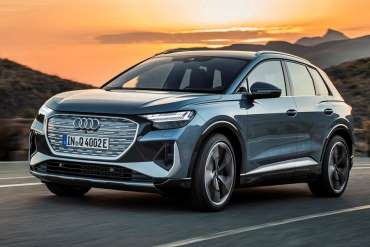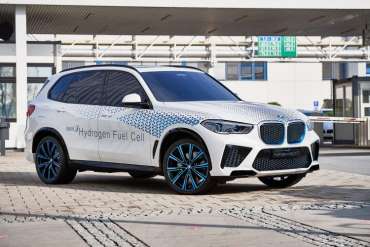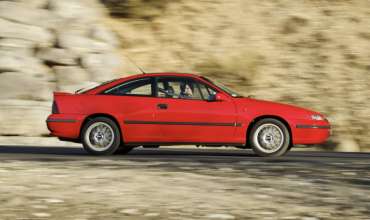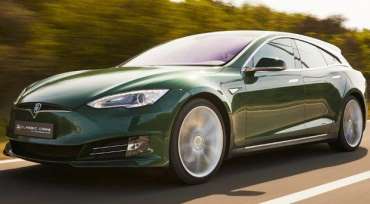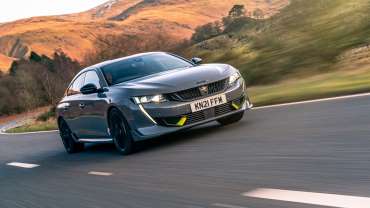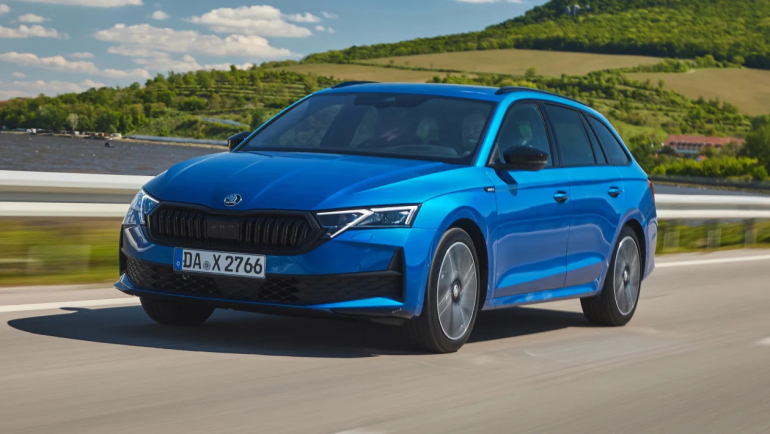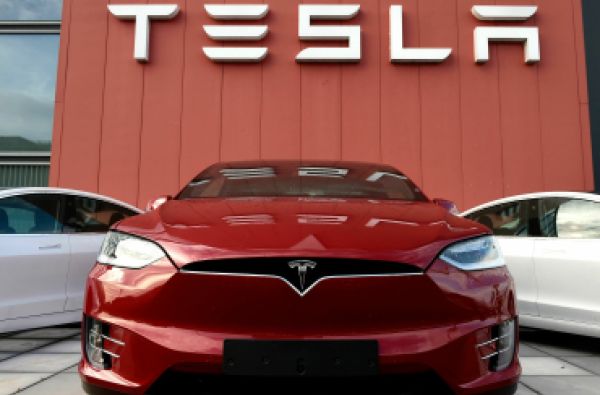
Worldcarblog.com
A refurbished BMW X3 is coming soon
The current BMW X3 was introduced to the public in June 2017 (developed under the code number G01), it is based on the CLAR platform and is 55 kg lighter than its predecessor, while the coefficient of air resistance is 0.29.
In terms of dimensions, the X3 is 4716 mm long, 1897 mm wide, 1676 mm high and has a wheelbase of 2864 mm. It should also be mentioned here that the volume of the trunk is 550 liters, or 1,600 liters with the rear seats folded down.
Now, almost four years after its premiere, BMW has also prepared an updated version of it. This is confirmed by this first official image that was in the public eye, and which suggests that the Prime Minister is very close.
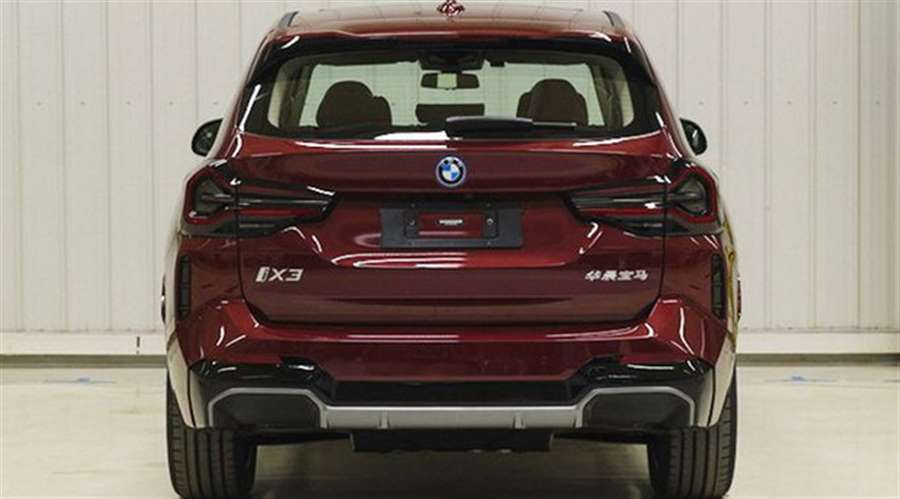
In any case, the trimmed front part, modified bumpers, front and rear LED lights, new design of aluminum wheels, new green color, gloss black details, as well as a modernized interior are expected.
There will most likely be no change in the engine range, so petrols with 184, 252 and 360 hp are expected, as well as diesels with 150, 190, 249 and 286 hp.
Also, the M versions with 480HP and 510HP respectively will be updated later.
As a reminder, the X3 M under the hood has a 3.0-liter six-cylinder engine with M TwinPower Turbo technology and 353 kW / 480hp and 600 Nm of torque. There is also a more powerful Competition version, which has 375 kW / 510 hp and 600 Nm.

The BMW X3 M accelerates from 0 to 100 km / h in 4.2 seconds, while the 30HP more powerful Competition model does it in 4.1 seconds. In both cases the maximum speed is el. limited to 250 km / h but with the optional M Driver’s Package this limit is 280 km / h (for regular X3 M) or 285 km / h (for X3 M Competition).
In addition, the plug-in hybrid variant X3 xDrive30e remains in the range, bringing a combination of a 2.0-liter four-cylinder turbo petrol with 184hp, an electric motor with 109hp, lithium-ion batteries, an 8-speed Steptronic transmission and all-wheel drive. The total power is 292 hp and 420 Nm, acceleration from 0 to 100 km / h takes 6.1 seconds, top speed is 210 km / h, and it is possible to drive only on electric drive (up to 46 km per WLTP).
Finally, the electric BMW iX3 will be adjusted, which in the current version has 210 kW / 286 hp and 400 Nm, and with one charge of lithium-ion batteries of 80 kWh exceeds 460 km (according to the WLTP standard). The Germans also state that 80% of the battery capacity can be charged in just 30 minutes with the help of a 150 kW charger. Acceleration from 0 to 100 km / h takes 6.8 seconds, while the top speed of this 2185 kg heavy vehicle is limited to 180 km / h.
Exposed! All Models From Toyota And Lexus Until 2024
What's planned through 2024? Read on.
The world will very much continue despite the coronavirus pandemic currently sweeping the globe. Although it's way too soon to know when life will return to normal, automakers are still preparing future models. Today, a massive leak has been exposed thanks to AllCarNews on Instagram revealing what Toyota and Lexus have planned through 2024. Some of the following has already been rumored but there's at least one new vehicle we didn't see coming.
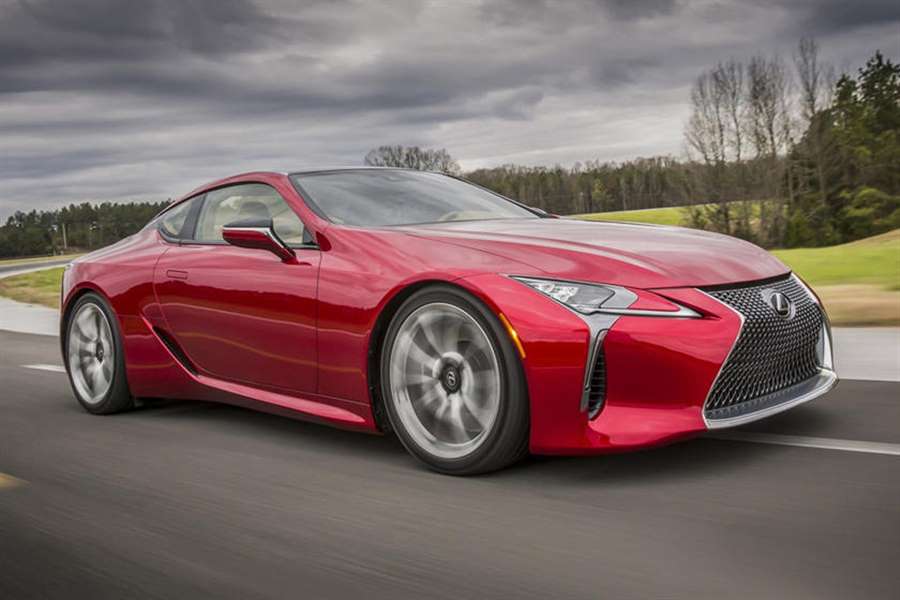
First up, the next-generation Toyota 86 and its sister ship, the Subaru BRZ. Both are expected to debut in July 2021 and the 86 will be rebranded the GR86. Power will come from a new turbocharged engine with a reported 255 horsepower. Rear-wheel-drive will remain, of course. Next, the Toyota Camry will also receive a mid-life refresh that year, followed by the Avalon in 2022. The next-generation Camry isn't due until 2024.
Also in 2021, we'll be seeing a new Corolla-based crossover whose name has yet to be announced. One possibility is Corolla Cross with production potentially taking place at the joint Toyota-Mazda plant in Alabama, which is still under construction. As we previously reported, the Toyota Venza wagon-crossover is also due to return in 2021. In all likelihood, it'll share a decent amount of its components with the Camry, once again.
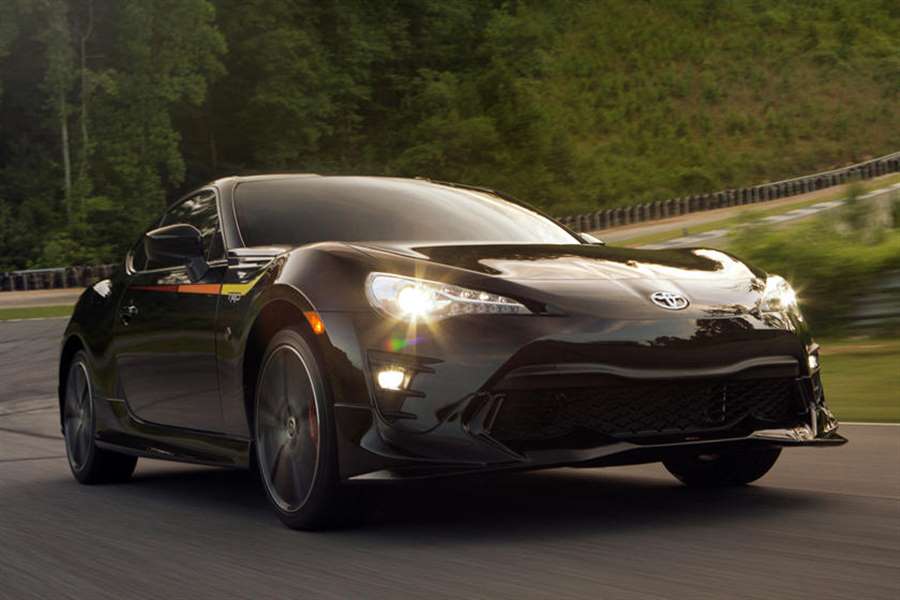
Moving on to trucks and SUVs, the leaked report indicates an all-new Toyota 4Runner and Sequoia will debut for the 2023 model year. Both will share the next-gen Tundra's TNGA-F architecture. The Sequoia and Tundra will ditch the 5.7-liter V8 in favor of a new twin-turbo hybrid V6. The 4Runner will get this engine as well. The redesigned Toyota Tacoma will arrive for 2024, but no precise details about it are yet available.
As for the Toyota Land Cruiser, it appears it will come in 2022 but unlike the current model, it'll be a stripped-out off-roader without a hint of luxury. In other words, it's going back to basics. Sweet.

As for Lexus, unlike the Land Cruiser, its LX counterpart will take the exact opposite approach by becoming a Bentley Bentayga rival, powered by the same twin-turbo V6. In general, Lexus is dropping all V8 models priced below $90,000. An all-new twin-turbo V8 will power the long-awaited LC-F in 2022. Also that year, the ES and LS will get a refresh. Surprisingly, the Lexus GS is being replaced outright by a Toyota Mirai-based RWD sedan.
Before that, the next Lexus IS, last updated in 2016, will debut in 2021, followed by a new RX and GX in 2023. Lastly, a new Lexus NX will come in 2021 and it'll ride on the TNGA-K platform with a total of five different powertrains and a new 14-inch touchscreen.

This is a lot of new information to take in, but Toyota and Lexus clearly have a very aggressive new product offensive on the way. We can hardly wait.
(https://carbuzz.com/news/exposed-all-models-from-toyota-and-lexus-until-2024)
Audi Q4 E-Tron price and spec details
Audi's take on the electric family SUV is cool and classy
Audi has revealed full details and prcies of the new all-electric Q4 E-Tron. It's the company's first electric car based on the same technology as the Volkswagen ID.3 and Skoda Enyaq iV and as well as being available as a regular SUV, you can also specify a coupe-like Sportback version.
The Q4 E-Tron introduces some new technology and offers some choice in terms of price and range. Firstly, there will be three variants from launch, the 35, 40 and 50 Quattro. As you may have already guessed, the 50 Quattro features all-wheel drive as standard – the 35 and 40 versions are rear-wheel drive only.
Rivals? There are a few that include the Skoda Enyaq iV, Volkswagen ID.3, BMW iX3 and Mercedes-Benz EQA and EQC. The market for mid-sized electric SUVs is really starting to heat up.
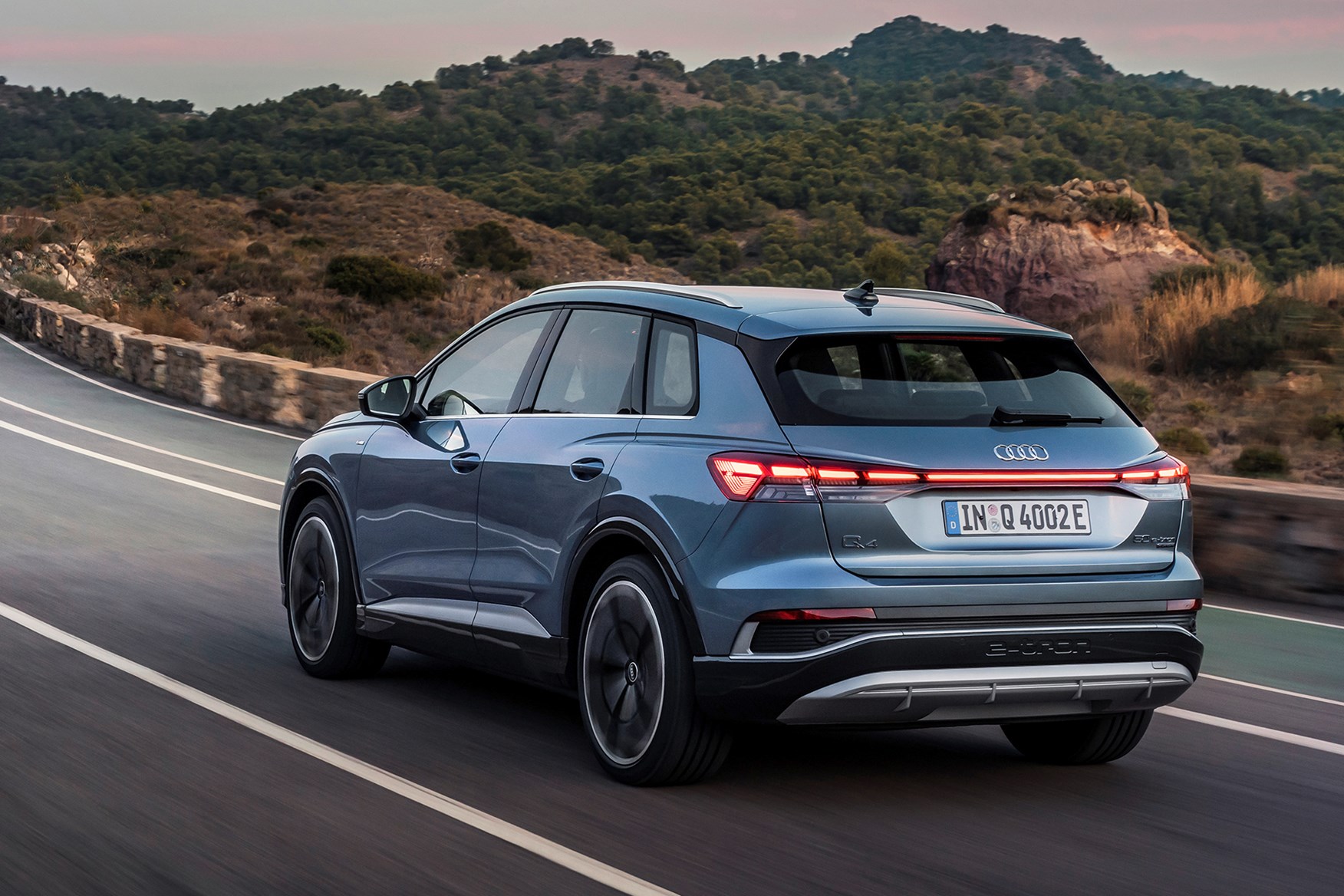
What it's like inside?
Details new to the Q4 E-Tron include a steering wheel with a flat top and bottom (with haptic touch panel buttons) on S Line models and additional storage cubbies, including bottle holders in the door armrests. The central MMI touchscreen (10.1-inch as standard, 11.6-inch as an option) still has haptic feedback like most larger Audis, but there is only one touchscreen, with manually-controlled air-con switchgear below it.
Much like Volkswagen’s ID.3 and ID.4, along with the latest Mercedes-Benz S-Class, the Q4 will be available with an optional augmented-reality head-up display. The AR-HUD actively displays navigation directions in your field of view, gives you markers for the car in front when you have the adaptive cruise system active and even flags up the edges of your lane if you stray out of them.
Audi is particularly promoting the practicality aspect of the new Q4 E-Tron, saying that while it has the rough exterior dimensions of a Q3, it has space inside akin to the Q5 and quality like a Q7. The Q4 has a sliding rear bench, allowing for a boot volume of 520 litres in the non-Sportback variant.
What models and trims are available?
The Q4 E-Tron is available to order now and UK deliveries are expected in June 2021. Trims available at launch will be the Sport, S Line and Edition 1 forms. Every battery and powertrain combination is available with each equipment level.
Even though Sport is the entry level, it still comes equipped with LED headlamps, a 10.1-inch MMI infotainment screen and aerodynamic 19-inch alloy wheels. The S Line model will undoubtedly be the most popular – as is the case with all other Audi models – and gains 20-inch alloy wheels, sportier-looking front and rear bumpers and lowered suspension. The special Edition 1 trim will be a more elaborate offering, with Matrix LED headlights and unique interior and exterior trim.
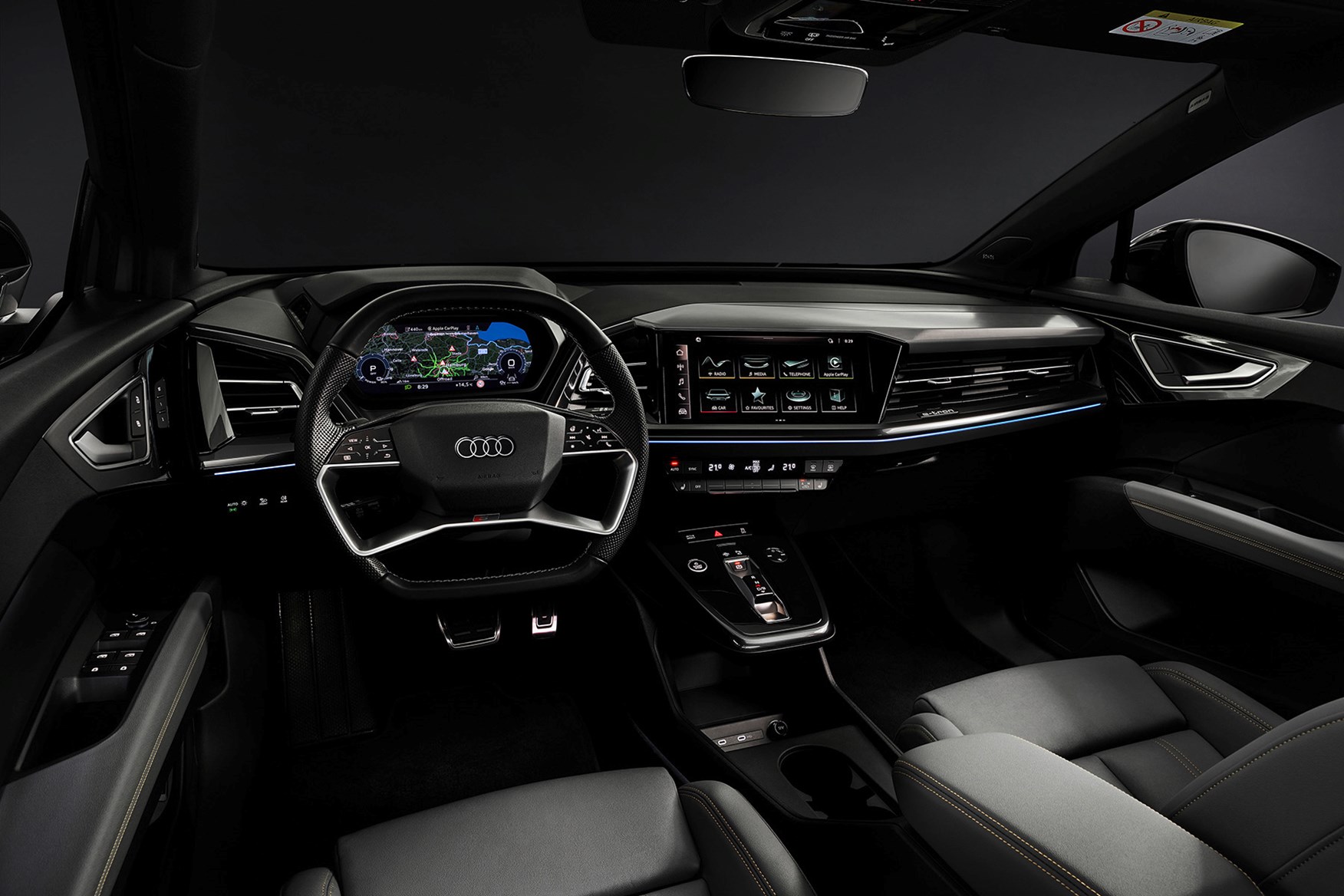
Expected to join the range after the initial launch in June 2021 will be the Q4 E-Tron Vorsprung. Audi has confirmed It’s priced from £54,450 and gains 21-inch wheels, Nappa leather-trimmed seats and a more comprehensive driver-assistance package.
What else should I know?
The Q4 E-Tron can support 11kW AC charging and up to 125kW DC charging, with Audi claiming around 80 miles can be zapped into its new EV in just 10 minutes using those fastest of chargers.
Very little has changed between the production Q4 E-Tron and the concept car that debuted a couple of years ago. The Q4 SUV’s relatively boxy shape is emphasised by clean-cut wheelarches, a blocked-out grille in a very familiar Audi shape, and a single light panel that stretches across the rear. If you choose the optional matrix LED lights, you can customise the way the daytime running lights look with four distinct patterns.
Audi also offers something called ‘E-Tron Charging Service.’ It’s not an unheard of concept from manufacturers – you’re essentially given an RFID card and sign up to a tariff that gives you streamlined access to chargers from different networks, saving you the pain of signing up to individual ones.
Should I order one?
If you like the look of it. the Audi Q4 E-Tron is available to order now, with prices starting from £40,750. That figure soon balloons by choosing plusher models, larger batteries and optiona extras. The question is how much you think it's worth the premium over its Volkswagen Group sister cars, the ID.4 and Skoda Enyaq iV. We can't really answer that until we've driven it.
No model in the Q4 E-Tron range is eligible for the government's £2,500 plug-in car grant. We do like the sheer breadth of models available and the classy interior – and look forward to driving it. You'll be able to read about that here first.
(parkers.co.uk)
The first BMW hydrogen models will arrive next year
The development of CO2-free propulsion technologies has become a top priority for the BMW Group. In addition to purely electric, they are now working on the development of hydrogen propulsion systems, which will first be implemented in the current BMW X5. The total power of the system will be almost 400 hp.
Like all electric cars, fuel cell models (FCEVs) use electricity to power electric motors. Unlike other electric models, FCEVs do not use energy from a battery but from a hydrogen fuel cell. In it, a chemical reaction takes place between hydrogen and oxygen, and thus a current is created that drives the engine. Thus, the use of this technology can help further decarbonization.
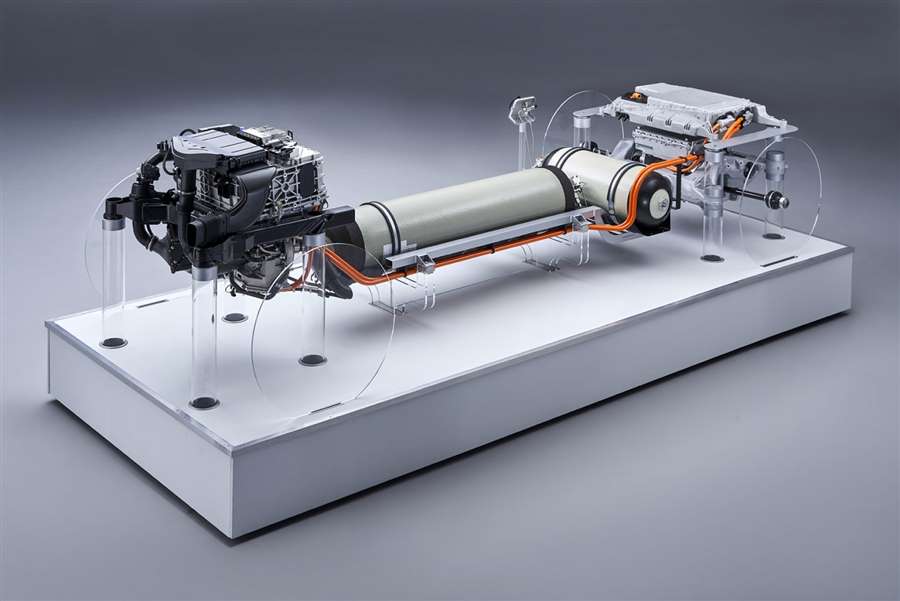
The BMW Group will launch small series of so-called Hydrogen NEXT models from 2022, and the new drive will be implemented in the current BMW X5, which will emit only water vapor as a by-product.
A key role in this is played by the Landshut Technology Center (LuTZ), which produces the most important components for hydrogen-electric propulsion, which will be installed in the BMW X5 models.
The system will use hydrogen and will generate up to 125 kW of electricity for an electric motor that is mounted on the rear axle. The tanks will be able to store 6 kg of hydrogen and oxygen, and the filling time is only 3 to 4 minutes.
The electric motor is the same as in the electric BMW iX3 SUV, and the total power of the system will be 275 kW, or 374 hp.
The most expensive Opel Calibra cost 300,000 German marks?
There is a reason why a 1993 Opel Calibra cost 300,000 German marks. It is a special specimen that came out of the workshop of the famous Günter Artz, a German car dealer, also known for, to put it mildly, the extravagant projects he made.
The Opel Calibra was produced from 1989 to 1997, and was an example of a car that, combining aerodynamics with a striking design (it had a record drag coefficient and then an outstanding appearance), gained a reputation as a cult coupe among enthusiasts.
But one of them, very special, under the sheet metal was actually the famous Opel Lotus Omega, which we recently wrote about.
The unique car was created by Günter Artz, a German car dealer who initially used Volkswagen models as a basis, after which he started using Opel. The goal, Artz says, was to pack performance and speed against all rules and amplify the impression of surprise.
Probably Artz's most famous car is the Golf 928. On the chassis of the damaged Porsche 928, he built a huge 240 hp Golf, which was 21 centimeters wider and 30 centimeters longer than VW's standard model.
In the test, it reached a top speed of 232 km / h, and its price was 150,000 marks, which is more than the original Porsche 928 with 300 hp. Given that, it is no wonder that only two copies of Artz's Golf were made.
However, enthusiasts believe that Artz's "Magnum Opus" was a yellow Lotus Calibra. With an output of 377 hp and a top speed of over 280 km / h, it was a perfect "camouflage", writes Auto Klub.
In addition to under the hood, Lotus' "ingredients" were also used inside the cab. The dashboard, steering wheel and leather seats come from Omega A, and the Lotus signature adorned the dials.
At the time Lotus was part of General Motors, powerful engines such as the 3.6-liter twin-turbo six-cylinder in the Omega or the 5.7-liter V8 in the Corvette C4 ZR-1 were being developed.
Artz initially focused on increasing performance. For the project, he assembled a Lotec version of the six-cylinder with 470 hp, but after bad experiences, a standard engine of 377 hp was installed.
The project was finally named Lotus Calibra - weighing 1.7 tons, shockingly powerful and surprisingly comfortable. Like the Golf 928, the Lotus Calibra was larger than the production version - about 16 centimeters longer and even 12 centimeters wider. In addition, larger alloy wheels wrapped in wider tires were used.
Production cost a real small fortune. The standard Opel Calibra was worth 45,000 marks at the time, and the windows alone, specially made in Italy, cost 13,000, and 17,000 marks had to be paid to Kamei for custom-made bumpers.
The final price of the Lotus Caliber was 300,000 marks, and only a few copies were produced.
The car was approved for use on a public road only in 1993, and the project fell silent after Opel terminated the dealership agreement, so it was shut down in 1995. A year later, Artz gave up the car business.
The unique Tesla Model S station wagon is still looking for its customer
In 2018, a Dutch company made the first of the planned 20 copies of the Model S Shooting Brake, and this car was even exhibited at the Geneva Motor Show in March 2019, where its design attracted the attention of four-wheeler fans.
In the end, there was nothing from the ambitious plan because the company failed in the meantime, but the first and only Tesla Model S Shooting Brake survived, writes B92.
This car is sold on the site AutoScout24.nl at a price of 224,521 euros, if the buyer comes from one of the countries of the European Union, while the price for clients from other parts of the world is reduced by VAT and amounts to 185,555 euros.
As it is stated, the original Tesla Model S, on which the caravan is based, was made in 2013, and the car has covered 65,000 km so far. The maximum power of the electric drive is 421 hp (310 kW).
Peugeot 508 Sport Engineered (2021) review: the hybrid shapeshifter
Meet the many-hatted Peugeot 508 Sport Engineered – in one package a stylish fastback, business-class motorway cruiser, zero-tailpipe-emissions planet-pleaser and now, apparently, a powerful sports car.
That's a lot of plates to spin. So it won't surprise you to hear Peugeot's turned to a flexible plug-in hybrid powertrain to achieve it, promising more power than a regular petrol or diesel with the option to run emissions-free for a claimed 26 miles too.
Thing is, the 508 is mostly bought by company-car drivers, who usually only require a posh badge to impress clients, an M Sport bodykit to impress colleagues, and a small diesel engine to impress the fleet manager. Does the PSE model over-complicate things?
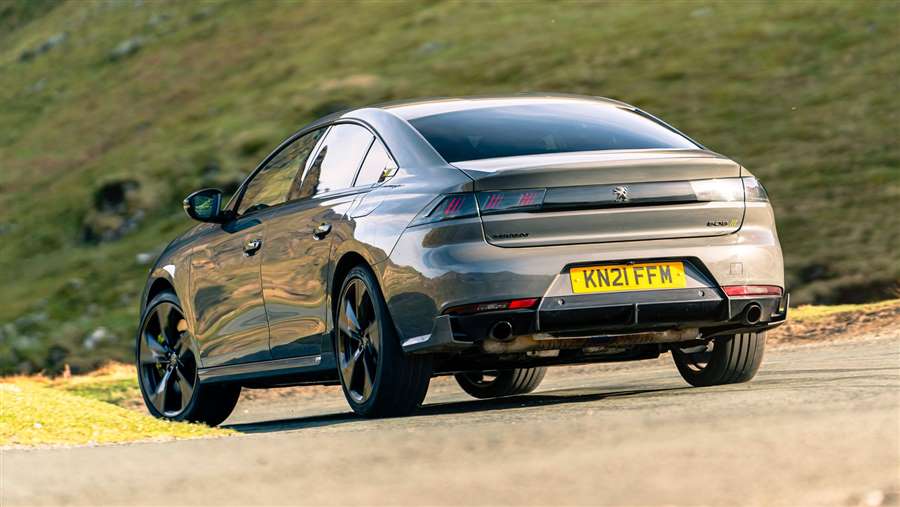
Who cares? It's a fast Peugeot!
Well yes, there is that, but consider the £50,000 price tag – for retail customers that puts the 508 PSE in the crosshairs of the BMW M340i and Audi S5 Sportback.
That's not an inherently difficult circle to square, because this is not only a fast Peugeot, but a very fast, very good Peugeot.
508 pse side pan
It's actually the most powerful roadgoing car the French maker has ever sold, in fact, with as much power in its electric motors as the 405 T16 we all so desperately want it to be.
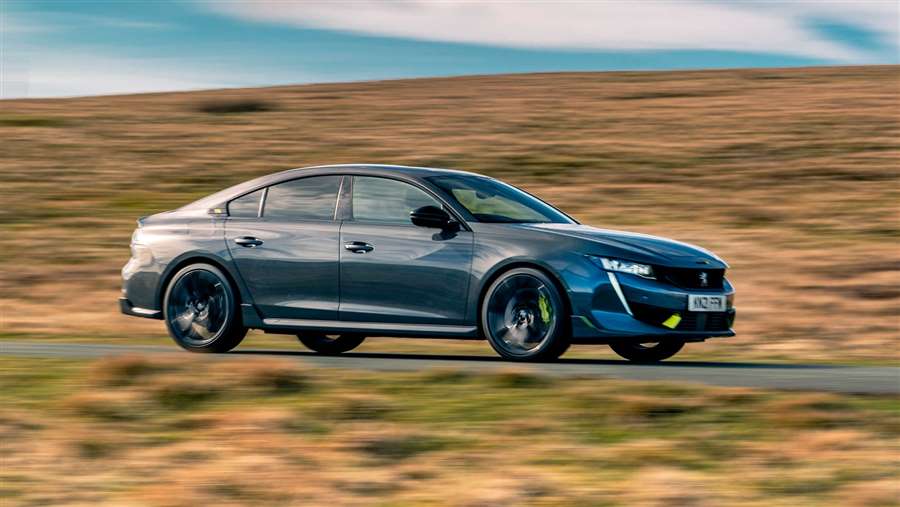
Why doesn't it have a GTi badge?
Peugeot says that's a question only British journalists ask, such is our love of the marque's heritage hot hatchbacks. But the 508 is something entirely different, offering a broader spread of talents than an out-and-out sports saloon.
The Sport Engineered name means it's a 508 first and foremost, with the benefit of being breathed on by Peugeot's go-faster division. It's WandaVision to The Avengers or The Mandalorian to Star Wars.
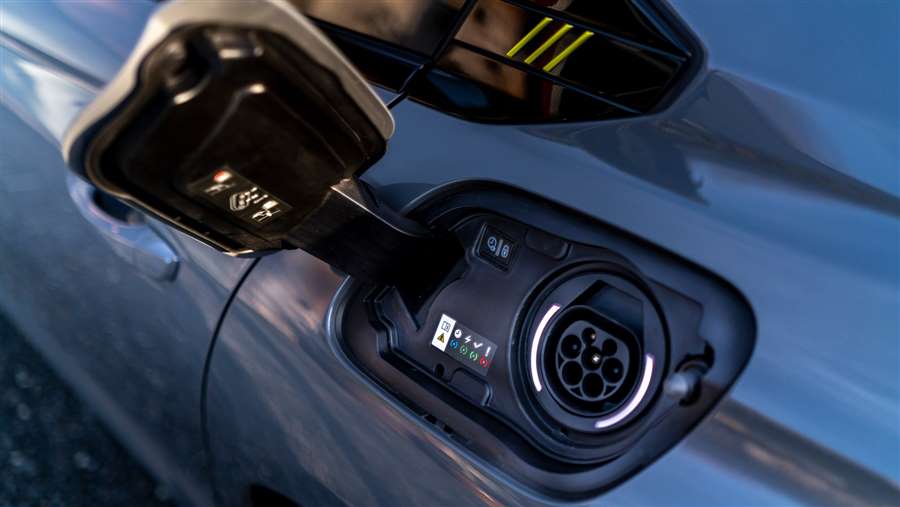
What's it like to drive?
Fast! But that shouldn't be a surprise, considering the 335bhp and 384lb ft of torque on offer from a 1.6-litre petrol engine and two electric motors, and an all-wheel drive system to help deliver it all cleanly to the tarmac.
It's not as fast as a pure-petrol M340i or S5 with those numbers, because it's heavier than a pure-petrol car. But it's not as heavy as you might imagine – the 1850kg kerbweight is actually pretty good for a PHEV.
The gearbox likes to shuffle up the cogs to save fuel (as is the way these days), but in Sport mode it seems to hang onto them for too long. The best solution is to use the column-mounted manual shift paddles, but these are too short and set too high – more suited to a ten-to-two driver than a quarter-to-three. Plus the left paddle is sandwiched between the left indicator stalk and cruise controls, and this is annoying.
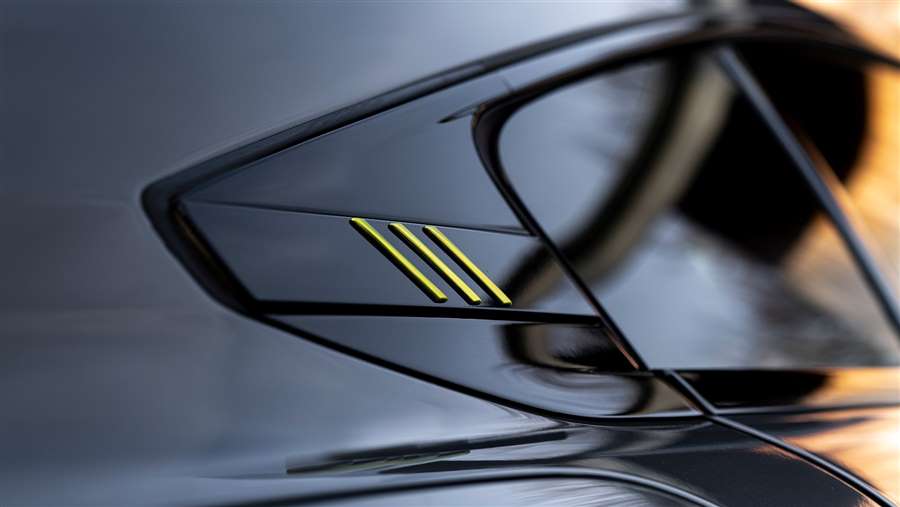
Things are better in the handling department where the 508 PSE is quite neutral in a corner and can be persuaded into a bit of lift-off oversteer as you'd expect in a car fettled by Peugeot Sport. This car is lower and wider than the standard model, and has its own springs, dampers and anti-roll bars.
The suspension is adaptive and offers a broad spread of settings, from comfy to firm, although there's always an edge to the ride that reminds you you're in the sportiest version. Otherwise it's typical Peugeot Sport – more hot hatch than a saloon, with light controls, a little bit of bodyroll, and agility and compliance to the ride, which adds huge fun on UK roads.
Only one thing stands out (and being a plug-in hybrid this won't surprise you): the brake pedal is spongy and hard to get dialled into. The 508 PSE is equipped with Alcon calipers and bi-material discs, which offer plenty of stopping power, but without mechanical pedal feel it can be hard to meter out.
How long does it take to charge?
The 11.5kWh battery takes about three to four hours to fill at the standard 3.7kW rate – a 7.4kW charger is an option, dropping the time to one hour and 45 minutes. Either way you only get a Type 2 cable, with no three-pin unless you pay for it.
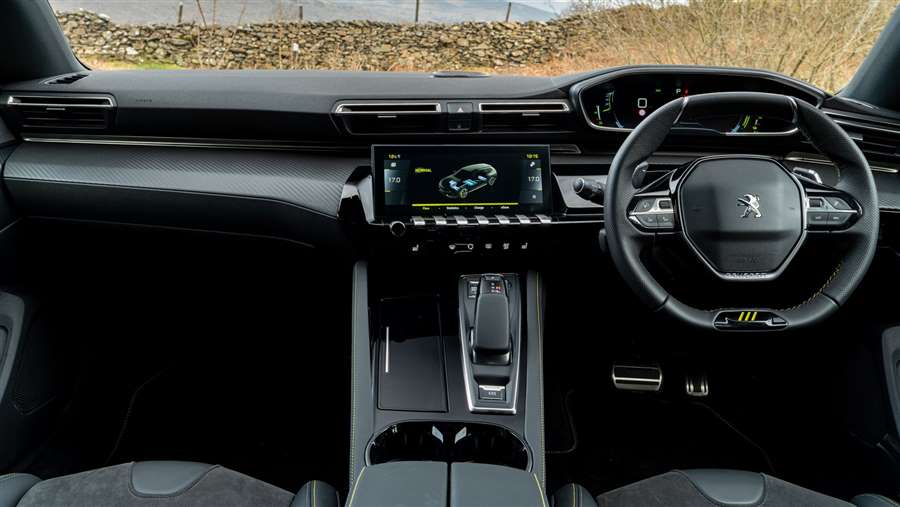
You need a full battery to get all 355hp, although with no charge the 508 will run as a sort-of hybrid in town, and on the whole it's pretty smooth and unobtrusive.
Pick up the pace, though, and you'll be greeted by the slightly reedy and over-synthesised tone of the petrol engine, which is alright when you want to cruise around in peace, but not very soul-stirring when you crack on. Still, that's another good reason to keep it charged.
Is it any different inside and out?
It's a pretty subtle change in exterior styling – from a distance – but as you get closer you'll notice all sorts of enhancements.
The most stand-out are the Kryptonite green additions, including the new claw logo, and the aggressive diffuser and aero ducting on the front bumper. Small vertical blades stick up on the edges of both and are probably more useful for tucking the cable into while the car's on charge than actually channelling air, but they're quite cool nonetheless.
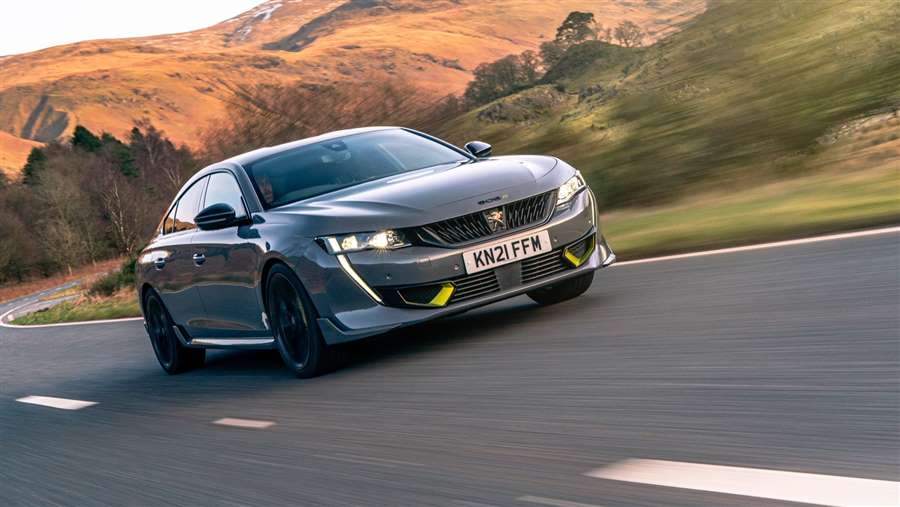
Inside, you still get Peugeot's divisive i-Cockpit layout with its tiny steering wheel set below the dials, but with more carbonfibre effect material. Overall it's a nice interior, very futuristic-looking, but the hard plastic used for the door bins and under the armrest stick out on a £50,000 car.
Peugeot 508 Sport Engineered: verdict
The 508 has been twice compromised in becoming this Peugeot Sport Engineered model – firstly by adding batteries and electric motors, and then again by giving it a performance focus.
What makes this car stand out against rival performance PHEVs is the fact it gives away very little in terms of outright practicality. The boot capacity is the same as a non-plug-in Pug at 487 litres, and despite being way more fun and accomplished to drive than the standard 508, it's barely any less comfortable day-to-day.
Yes, an old-school straight-six would be a more evocative powerplant, but the ability to drive emissions-free and the overall improvement in fuel economy in this 508 goes a long way to addressing that balance. It's an odd niche, but one that deserves plugging.
(carmagazine.co.uk)


